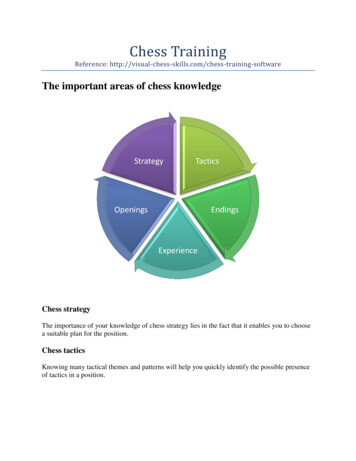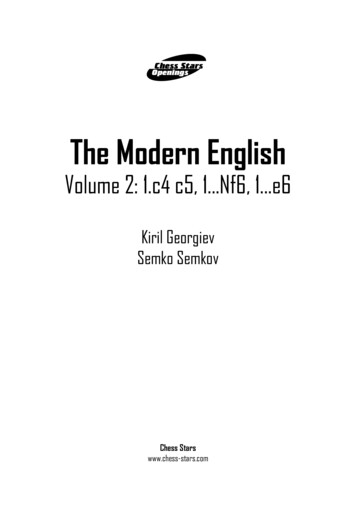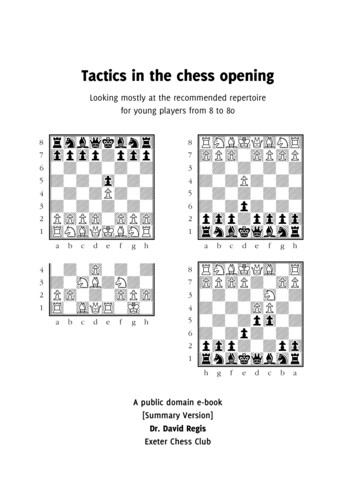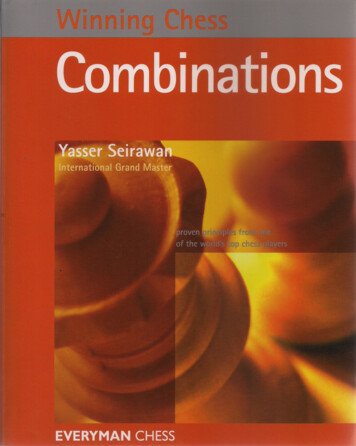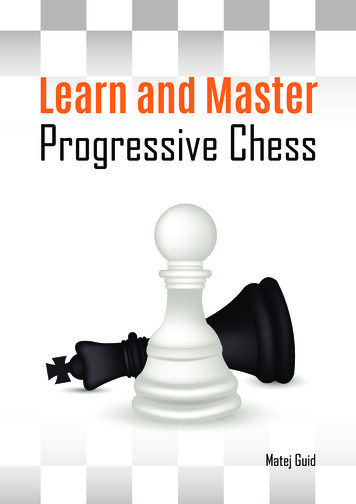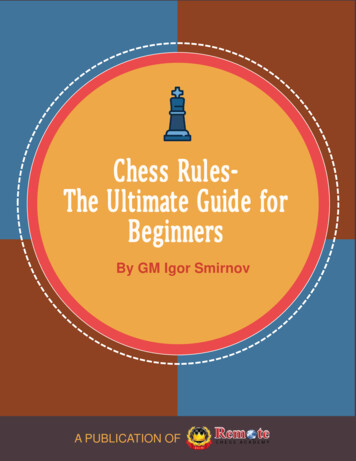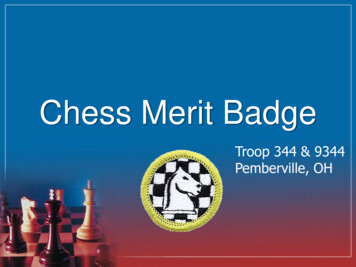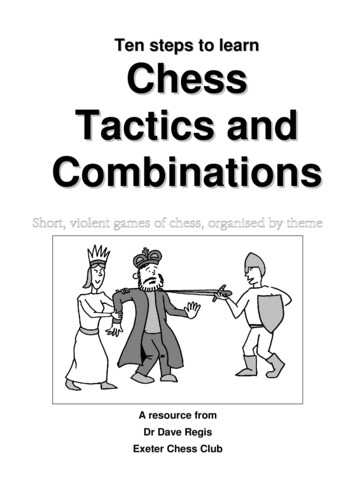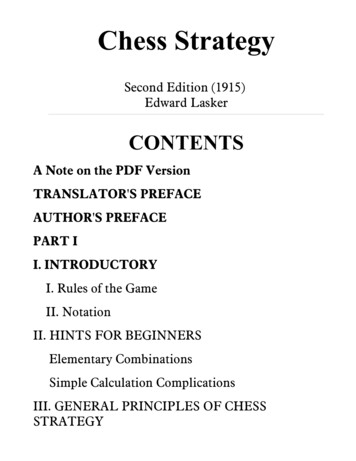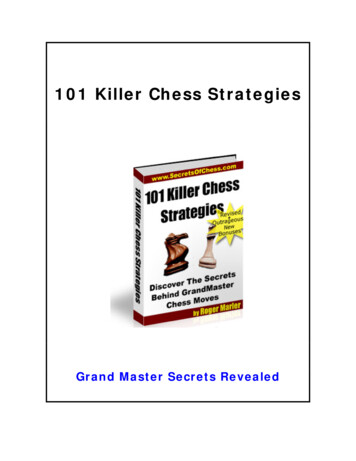
Transcription
101 Killer Chess StrategiesGrand Master Secrets Revealed
Welcome to the 101 Chess Strategies ebook! This is acompendium of some of the greatest chest moves that have ever beenconceived by chess masters throughout history.Before you try to decipher the information in this book, I stronglyrecommend that you read the first chapter called "A Word aboutNotation." This will help you understand the code that is used to helpyou to visualize the moves on the chessboard.In this book, you will find information about the eight most deadlytactical moves and positional plays. You will also discover the types ofgames that can evolve as a result of using the two most popular initialopening moves - White pawn e4 and d4. In Chapter 5, you are shown86 ways to respond to those initial moves and transport your pieces intoan advantageous middle game.We also talk strategy in this book by discussing the importance ofplaying your pieces instead of pawns and showing you how to avoidgames that end up in a draw.If you have always wanted to play to win, then keep scrollingdown these pages to read more or you can peruse the Table of Contentsbelow to find the section that most interests you!Pg 2 of 180
Table Of ContentsCHAPT 1: An Overview .7Part 1. A Word About Notation .7Decoding the Board .7Decoding the Pieces.8Figurines.8How Notation Describes Moves .9More Chess Notation Lingo .9Part 2. The Fine Art of Trading Pieces. 11Part 3: The Importance of Pattern Recognition . 12Part 4: The Phases of the Game . 13The Opening . 13Basic Opening Principles . 13Additional Opening Principles . 14Strategic and Tactical Ideas . 14Typical Opening Problems. 15The Middle Game . 15Who is better? . 16Evaluation, Planning and Analyzing . 17Tactical Middle Game Guidelines to remember . 18General Principles of the Middle Game . 19The Importance of Schematic Thinking In The Middle Game . 19Planning for the End Game . 20The End Game . 21What is an end game?. 21Important End Game Principles . 21Pawn Endings . 22Rook Endings. 23Knight Endings. 24Bishop against Knight . 25Bishop Endings – Same color squares. 26Bishop Endings – Opposite color squares . 27Queen Endings. 27Some Illustrative End Game Principles. 27Chapt 2. Tactical Combinations .29The Fork . 29The Pin . 30The Discovered Attack . 31The Discovered Check . 32Overloading. 33Decoy . 33The Xray . 34Pg 3 of 180
Chapt 3. 3 Winning Positional Plays .351. The Four Center Square Advantage. 35Some general rules to remember about the center:. 372. Open Lines for Rooks & Queens . 37Strength of the seventh and eighth rank. 383. Pawn Structures. 39Locked Pawn Chain. 40Passed Pawns . 41Isolated Pawns. 41Doubled Pawns . 42Strong and weak Squares. 43Pawn Structure Exercise . 45Chapt 4: 2 BEST Initial Moves .471. Pawn to d4 The Queen's Pawn. 472. Pawn to e4 The King's Pawn. 49Chapt 5: 86 Unique Opening and Middle Game Moves 52Part 1. Responses to White Moves To d4 . 52The Albin Counter Gambit. 52Typical Variation . 53Benko Gambit . 53Benoni . 54Benoni Used as A Way into the English Opening. 54Benoni Used As a Way into the Benko Gambit . 55Dutch Defense . 56Gruenfeld Defense. 58King's Indian Defense . 60An example of a Four Pawns' Attack From King's Gambit. 61Nimzo Indian Defense . 63Queen's Gambit . 66Queen's Indian Defense . 66Part 2. Responses To White Moves To e4 . 69Alekhine's Defense . 69Four Pawn Attack . 70Bishop's Opening. 71Caro-Kann Defense. 72The Scandinavian Defense . 75Playing the Center Game . 77Dutch Defense . 78French Defense . 81Giuoco Piano. 84Evans Gambit . 84King's Gambit . 85Petrov's Defense . 86Pg 4 of 180
Philidor's Defense . 88The Spanish Game . 91Unique Opening Moves and Responses . 95Bird's Opening . 95English Opening . 96Nimzo-Larsen Attack. 97Reti System (moving a Knight). 100Chapter 6. Playing Royalty Not Pawns -7 Good Moves . 101Rook on the 7th rank . 101Two Rooks on the 7th rank . 102Blockade . 104The Extreme Blockade . 104Attacking A Chain of Pawns. 105Chapt 7. Ten Conquering End Game Moves.107King and Queen vs. King . 107King and Rook vs. King . 107King and two Bishops vs. King. 108King and Pawn Versus King. 109Rook vs. Pawn . 109Weak King in front of Pawn . 111Chapt 8. When Is A Game A Draw? .112Stalemate . 112Perpetual check. 113Triple repetition . 113The Fifty Move Rule . 115Mutual agreement . 116Time Trouble . 117CAUSES OF TIME TROUBLE. 117PRACTICAL ADVICE . 118If you are in time trouble: . 119If your opponent is in time trouble:. 119Recommended Reading Resources.120Appendix A.121The Immortal game – Anderssen Vs Kieseritzky . 122References . 128Evergreen game – Anderssen Vs Dufresne. 130References . 131Opera game – Paul Morhy Vs Duke, Isouard . 132References . 134The Game of the Century – Byrne Vs Fischer . 135References . 139Deep Blue - Kasparov, 1996, Game 1 . 140Final Position . 142Pg 5 of 180
References . 142Kasparov versus The World . 144Pre-game speculation and preparation. 146References . 169Helpful Web Sites.170Chess Glossary .171Pg 6 of 180
CHAPT 1: An OverviewPart 1. A Word About NotationDon't try to read any further until you have familiarized yourselfwith the chess notation that we are using to describe the winningmoves in this book! Chess notation is a kind of a code which gives usthe means to record chess games and to discuss and describe specificpositions on the chessboard.The chess notation that we will be using in 101 Winning ChessTactics is called Algebraic Notation. Algebraic notation is the mostcommon notation in use.Decoding the BoardAlgebraic notation assigns the numbers 1 through 8 to the lateralrows that make up the 64 squares of the chessboard. For the verticalcolumns of squares, it assigns the letters a to h. The square at theintersection of a column and a row is identified by the letter first for thecolumn and then the number for the row. For instance the very topleft-hand corner of the board would be denoted as a8.Please refer to the diagram on the next page that demonstrateshow two character notations that correspond to each square on thechess board.Pg 7 of 180
The square in the lower left is 'a1', while the square in the upper right is'h8'. In this book all of the diagrams will be displayed with White'skingdom at the bottom and Black kingdom at the top.Decoding the PiecesA single letter identifies the pieces. The figurine notation used in thisbook is:FigurinesP for PawnN for KnightR for RookB for BishopQ for QueenK for KingNotice that an N or n denotes the Knight, even though it starts with a Kto avoid confusing it with the K or k for King.Pg 8 of 180
How Notation Describes MovesWe describe a move by putting prefacing the letter for the figurine infront of the move. Example Pa4 (black piece moves up two squares inmost right hand column)An example of Pa4Notation also allows us to generically describe certain geometricalqualities of the board. Here are a few common examples that you willencounter in the notation in this book.More Chess Notation LingoRank is the traditional technical terms used to describe the lateralrows of square and File is the term used to vertical columns of squares.In this book, I try to refer to the 7 rank or the f-file rather than confusethings by trying to describe things as the seventh row or the f columnor f row.The center consists of the four squares: d4, d5, e4, and e5.The queenside and kingside are the halves of the board to the leftand the right, again from White's point of view. The names correspondto the initial positions of the Queen and the King.Pg 9 of 180
Similarly, the White side and Black side are the lower and upperhalves of the board facing each player.The diagonals are determined by their starting and endingsquares moving from left to right. The 'a1 to h8' and 'a8 to h1'diagonals consist of eight square each and are the longest moves thatyou can do on a chessboard.Notation for Special MovesSome moves are described using special notation terms.Castling is denoted by O-O for castling kingside and O-O-O forcastling queenside.Pawn promotion to Queen is handled by adding the promotingpiece to the move. The move 'e8pQ' means that the Pawn is beingpromoted to a Queen.Ambiguous moves are moves where two pieces of the same typecan move to the same square. Suppose, for example, that White'sKnights can both move to f3. To differentiate between the two pieces,the originating square would also be included in the notation. Instead of'Nf3', we write 'Ndf3' or 'Ngf3' to show which Knight is supposed tomake the move. When the file is the same for both pieces, we describethe move using rank. The notation 'R7a4' means that the Rook on the8th rank is moving to a4 rather than, say, the Rook on the 1st rank.An 'x' sometimes indicates a capture of a piece. If a Bishop movesto b7 and captures a piece, this can be written as 'Bb7' or 'Bxb7'.Check is often indicated by a ' '. If a Crown moves to f6 and theKing is on f8 and offers a checkmate, this can be written 'Nf6 .Almost all chess literature published today uses algebraicnotation, but this was not always true. Many older books and magazinesused a system called descriptive notation.Pg 10 of 180
Part 2. The Fine Art of Trading PiecesSometimes during the course of a game you will be allowed totrade pieces with your opponent. Knowing the difference between a fairtrade of pieces can be crucial to strategizing an eventual victoryHere is the value of all of the figurines except for the Kingwhich is never traded for another piece.Queenequals 9Rookequals 5Bishopequals 3Knightequals 3Pawnequals 1The following illustrations show the equivalent worth ofsome pieces to others.Minor piecesTRADES FORTRADES FORTRADES FORRookTRADES FORTRADES FORTRADES FORPg 11 of 180
QueenTRADES FORTRADES FORTRADES FORPart 3: The Importance of PatternRecognitionMany maintain that pattern chess masters are made not born.There are many skills that make a master, but one of the mostimportant is pattern recognition. In order to be a conqueror at chessyou need to train your brain to visually recognize familiar situations aswell as file away your best strategic options when it comes to movingthe pieces in such situations. It is very possible that most chess mastersare not that intelligent, but rather, possess an excellent photographicmemory.After the first two opening moves an average player will findthemselves considering about forty to fifty possible legal moves! Anovice will assess the position of their pieces and work out the legalmoves one by one. Thinking in this linear fashion often causes them tolose the game, as they are not seeing "the big picture."An intermediate player will most likely immediately perceive thepotential moves on the board but will have some problem determiningwhich moves are most likely to lead to a quick win or a win with a greatpoint value.A master chess player is able to simultaneously envision all of thelegal moves and quickly decide what moves will have the mostpromising outcomes.Like playing the piano, playing chess takes practice. The way tobecoming a winner in chess is to practice pattern recognition each timeyou play or watch a game. Sooner or later this will help train your mindwithout thinking twice.Pg 12 of 180
Part 4: The Phases of the GameYour winning strategy depends on realizing which phase of thegame is at play. The three basic phases are the opening, the middlegame, and the end game. The correct transition from one phase toanother can mean the difference between a win and a draw -- or a drawand a loss.This book is organized so that three of the chapters "33 KillerOpening Moves", "Making The Most of Your Middle Game" and"Conquering with End Game Moves" focus specifically on the maindefining phases of the game. The following is a detailed description ofeach phase and some basic but critical principles you MUST apply togive yourself the best advantage during play.The OpeningIn the opening phase of the game, each player will attempt todevelop their pieces to achieve two main objectives. One, to be readyfor attack, and two, to interfere with the development of the opponentsforces. In theory, white gains a slight advantage by moving first but thisis usually not enough to gain a winning position and as each player getsa turn to move, the game is roughly equal.However, the more tempi (time) that you can gain to mobilizeyour pieces; by development, by checking your opponents king andmaybe causing them to lose the right to castle, or by preventing themfrom developing normally, the better prepared you will be in the middlegame.Basic Opening PrinciplesThese are the five key elements every successful player needs tounderstand for successful opening play.-Fight to control the center (more explained later in chp 3)-Rapid and purposeful development of the pieces-The creation of a sound pawn structure with no weaknesses(more in chapter 3)-The co-ordination of the pieces and pawns-King safetyPg 13 of 180
Additional Opening Principles1) Major pieces (rooks and queens) should not be developedprematurely since pieces of lesser value may develop with anattack on them resulting in loss of time.2) Don’t make unnecessary pawn moves. Only move pawns thatfacilitate the development of the pieces.3) Begin the game with a central Pawn move.4) Avoid useless checks, this wastes time.5) Always assume that your opponent will find the correct reply anddon’t play for crude threats unless your position is desperate.6) With the aid of pawns try to gain space advantage7) Don’t be too eager for material gain. In the opening stages it ismore important to develop all the pieces rather than search formaterial gain.8) Chess is played on the total board so don’t concentrate yourattention on one sector.9) Seize open lines.10) Try to prevent your opponents king from castling11) If cramped, free your game by exchanges12) If your opponent is cramped then try to avoid exchanges13) Try to exchange bad minor pieces.Strategic and Tactical IdeasOnce you have read and learnt these basic principles, you will need tostudy some of the major opening systems discussed in chapters 4 and5.Pg 14 of 180
Typical Opening ProblemsThese are some of the most common problems faced by many beginnerto intermediate players, and in some cases even the pro’s! By listingthem below, hopefully you will be aware of them and not encounterthem in your games.Here we go1) The player has chosen an opening unsuited to their style andtemperament. Quite often it is glaringly obvious that the playerhas chosen an opening that fails to complement their talents. Thisis where developing your opening repertoire and sticking to it ismost important (more on this in the bonus)2) The player has chosen an opening that is ideally suited to theopponent. This assumes prior knowledge of the competitor.3) The player has played the opening by rote and didn’t understandthe middle game ideas that followed.4) Being intimidated or overawed by a higher rated opponent5) Underestimating the ability of a lower rated opponent6) Playing for Win at all costs.*Note, see chapter 4,5 and Appendix A for more on opening moveexamplesThe Middle GameSo now you have developed your pieces to active squares andmaybe even castled your king into safety, now what? The phase whichfollows on from the opening is known as the middle game. This is whereyou need to settle down and consider your battle plan. Will you attackyour opponent’s king? Will you take over the center and push youropponents back? Or perhaps you might pressure his queenside withyour bishops and try to pick up a few pawns?Pg 15 of 180
The choice has to be made and made with care. It is better tohave a plan and stick with it then to have no plan at all.Who is better?Look at the following positions and imagine that you have been askedto take the pieces and take over the game. How would you assess thepositions and begin to choose a continuation? In each case be sure tobear in mind the following aspects:-The Tactical situation-The position of the pieces-The material situation-The pawn structureFig 1.1In Fig 1.1, white is winning on material – he is a Bishop ahead! Ifthe remaining pieces where to be exchanged he would be able to usethat extra piece and his king to harass and capture the black’s pawnsand that would win easily!Your immediate plan should be to actively exchange as manypieces as possible, without compromising your position or allowing blackto conjure up a counter attack.Pg 16 of 180
The wisest move for white in this scenario would be Qxf6 andexchange queens immediately.Evaluation, Planning and AnalyzingThe following is an example which takes all these important middlegame principles into account.Fig 1.2 (Kasparov vs Petrosian, Tilburg 1981)The initial evaluation should highlight the fact that white is a pawndown but is better placed because he has more space, better placedpieces, a good knight outpost on e5, control of the b file and a goodattack against the black king.The various plans should now be discussed without making any actualmoves. For example the 3 possible plans for white would be.Plan A – Take control of the b6 square by playing Pa5, then treble up onthe b-file by Rcb2 followed by Qb1.Plan B – Place the knight on the outpost e5 to attack the squares c6and g6.Plan C – Take further control of the dark squares by re-routing theblack squared bishop via c1 to a3.Pg 17 of 180
The final step of the analysis would show that Plan A is the correctoption since it is difficult for black to defend against all of the threatsfrom the trebled pieces on the b-file. Plan B faces the possibility, thaton 31. Ne5 black could play 31 Nxe5 removing whites threats. Plan Cseems good but the outcome is less clear with many tacticalcomplications.Pawn StructuresThis is another major part of the middle game, however this will bediscussed in more detail in chapter 3.Tactical Middle Game Guidelines torememberThe following guidelines are useful when considering tactics in themiddle game.1) Indications that a combination may be possible-Exposed king-Any undefended unit-Major piece on the same rank, file or diagonal as one of yourpieces-Pinned piece-A piece tied to the protection of another piece-A piece with either no retreat, or with only one retreat which canbe cut off-A castled king without a protected piece-An overworked piece2) Where feasible don’t defend pieces with other pieces3) Don’t indulge in dubious or useless combinations when othermeans of victory are available. Such combinations should only bePg 18 of 180
played in losing positions or when one has committed oneself to acertain line of play.4) A discovered check is such a powerful weapon that a sacrifice isoften justified to bring it about.5) When castled on opposite wings, the attack must proceed rapidly.Usually lines of attack are opened by pushing and sacrificing onespawns at the enemy king.General Principles of the Middle Game1) When experiencing difficulty in formulating a plan in quietpositions, try to create a plan that involves activating your mostinactive pieces2) It is better to have a plan than simply to play to move. Howeveryou must be flexible and be prepared to alter or modify your planas circumstances demand.3) Possession of an open file may be enough to win if there areadditional points of attack.4) When in possession of a pawn majority, the objectives are tocramp your opponent, create a passed pawn tie down the enemypieces and then switch the attack to another sector of the board.5) Always look for the opportunity of a transition to a favorable endgame6) Good defense requires coolness and the willingness to makeconcessions.The Importance of Schematic Thinking InThe Middle GameA hallmark of all good players is their ability to think schematically,visualizing the ideal deployment of the pieces rather than indulging inconcrete analysis of the type “I go here he goes there”.Pg 19 of 180
The following example illustrates this important middle game principle.Fig 1.3 (Short vs Timman, 1991)The above position can be used to demonstrate schematic thinking. Asan exercise you should try to visualize the ideal deployment of the whiteking before reading on.Here is the actual game continued 32. Kg3, Rce833. Kf4, Bc834. Kg5, 1-0The best place for the deployment of the king would be h6 and as youcould see this plan could not be stopped.Timman resigns since he could not stop the moves that follow which are35. Kh6 and36. Qg7 Planning for the End GameWhen you have learnt more about the various types of end gameswe are about to study, you will soon discover that in the middle game,and even in the opening, it is possible to think ahead to the end gamePg 20 of 180
and make a rough judgment as to whether you could win the resultingposition. For example, if your opponent loses a pawn early on, and youare confident in playing pawn end games then you should aim toexchange as many pieces as possible. This not only prevents youropponent from generating a counter attack to compensate for theirmaterial deficit, but it will simultaneously increase the real value of yourmaterial advantage. You should also ensure that your king is going tobe ready to be brought into the center of the action should an endgame arise.The End GameWhat is an end game?The end game is the final phase of the game, usually occurring after theQueens have been exchanged and neither player is likely to be able tomate by a direct attack on the opponents King.Important End Game PrinciplesBefore studying the end game, make sure you familiarize yourself tothe following end game principles. However, it is essential to stress thatthe guidelines are only a useful background against which to view theend games, and that every position must be judged on its own merits.1) Passed pawns must be pushed as far to safety as possible,since they will then tie down enemy pieces allowing a breakthrough in another sector of the board. Pawn promotion isanother obvious reason.2) King activation – The king is a fighting piece in the end gameand must be used actively, try to centralize by moving towardsthe center3) Infiltrate the opponents position but at the same time try toprevent your own position from being infiltrated.4) Exchange off Bad pieces – To win you must exchange offpieces, this becomes an advantage particularly if it is material ittakes on a greater significance the fewer pieces there areremaining. Exchange pieces which do not contribute to youradvantage. Your aim is to leave your opponents with bad bishops,or a knight stuck out on the edge of the board.Pg 21 of 180
5) Material – has a decisive effect on the end game so be wary ofsacrificing pawns for development6) Pawn Moves – Must be considered carefully as they are the onlypieces that cannot move backwards.7) Fewer Pawns – It is usually an advantage to have fewer
with the chess notation that we are using to describe the winning moves in this book! Chess notation is a kind of a code which gives us the means to record chess games and to discuss and describe specific positions on the chessboard. The chess notation that we will be using in 101 Winning
